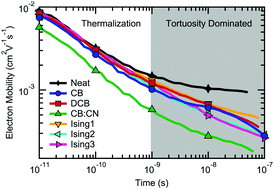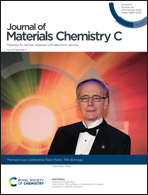Charge transport and mobility relaxation in organic bulk heterojunction morphologies derived from electron tomography measurements†
Abstract
The charge carrier mobility is one of the most critical electronic materials properties that determines the ultimate performance of organic photovoltaic (OPV) cells. However, it is also a property with complex dependencies on the charge carrier density, electric field, lengthscale, and timescale, which can each vary depending on the chemical structure, molecular order and orientation, phase morphology, etc. These issues have made it extremely challenging to develop quantitative structure–property relationships that would allow rational molecular and materials design for next generation OPVs. Using a unique combination of advanced experimental morphology characterization (electron tomography) and recently developed open-source computational tools for morphology analysis and kinetic Monte Carlo charge transport simulations, we investigate how the microstructural features in real bulk heterojunction blends impact charge transport physics. This work demonstrates that simulated charge transport in real morphologies can differ significantly from that found with the commonly used Ising-based model. However, most significantly, there are fundamental differences in the mobility relaxation dynamics between homogeneous neat materials and bulk heterojunction blends. The tortuosity of the bulk heterojunction domain network causes electric-field-induced dispersion that can significantly prolong the mobility relaxation dynamics. These morphological effects must be considered when analyzing experimental mobility results and when choosing the appropriate measurement technique.

- This article is part of the themed collection: Celebrating Tobin Marks’ 75th Birthday


 Please wait while we load your content...
Please wait while we load your content...